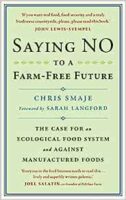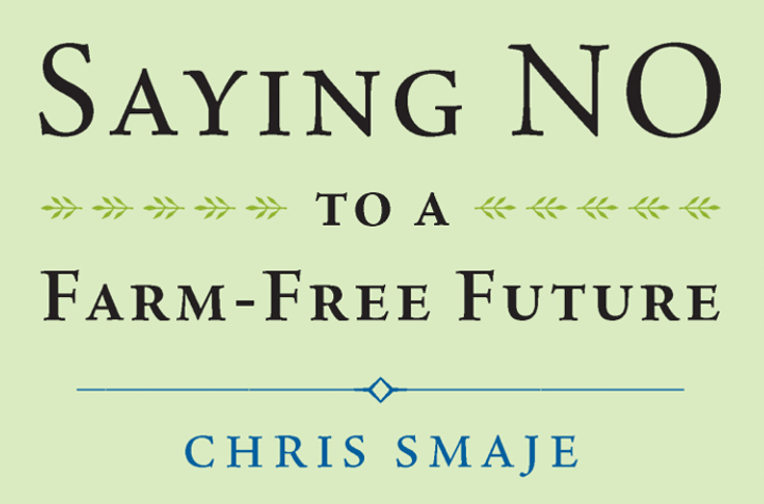 This excerpt is from Chris Smaje’s new book Saying NO to a Farm-Free Future (Chelsea Green Publishing UK, June 2023) and is reprinted with permission from the publisher.
This excerpt is from Chris Smaje’s new book Saying NO to a Farm-Free Future (Chelsea Green Publishing UK, June 2023) and is reprinted with permission from the publisher.
The Cost of Manufactured Food: Land and Energy
An important part of the rationale for manufactured food is the cost to nature of what Monbiot calls agricultural sprawl, suggesting the need to cut agricultural acreage. I’ll look at some of the wrinkles in this land-sparing argument later on. But if, for the moment, we accept it, then there’s some evidence to suggest that manufactured food might help.
For example, a detailed study published in the Proceedings of the National Academy of Sciences (PNAS) has found that a hectare of land devoted to protein-rich microbial biomass production energised by solar (photovoltaic – henceforth PV) panels could potentially produce 15 tonnes of protein per year.1 Whereas a hectare of soybeans, the authors report, only produces 1.1 tonnes of protein.
It has to be said that the PNAS study makes various assumptions rather favourable to the case for manufactured food, one of which is to use figures for incoming solar energy to the panels typical of places such as Southern California (around 2,000 kilowatt-hours per square metre per year – the corresponding figure in the UK is about 1,000) and a global average figure for soy yields. So, the 15:1.1 ratio is probably best taken as the upper limit of land-sparing possibilities for manufactured food (Monbiot claims the possibilities are greater, but on the basis of flawed figures, as I’ll suggest in a moment).2 It must also be borne in mind that no large-scale manufactured food facilities yet exist, so all these figures remain speculative.
On the upside, the PNAS study provides a lot of useful detail, and its comparison between PV-energised manufactured protein and soybeans is appropriate. The electrical energy required to make protein via the manufactured food route could be generated by any method, including fossil fuels, but PV panels are a sensible choice for evaluating the case for manufactured food because they’re probably the best bet globally for future low-carbon energy, even though they’re themselves a land-hungry way of tapping energy. And soybean rather than meat protein is the appropriate comparison because, as I argued previously, if the name of the game is efficient feeding of the Global Standard Consumer, then looking at the optimum product from the Global Standard Farm in comparison to the manufactured food approach is the right way to go about it.
One thing the PNAS study doesn’t do overtly is provide a figure for the amount of electrical energy required to manufacture the 15 tonnes of protein on the nominal hectare. To his credit, Monbiot does provide such a figure, although he doesn’t cite a source for it. He states that the manufacture of Solein uses 16.7 kilowatt-hours (kWh) of electrical energy to produce 1 kilogram (kg) of protein (to give an everyday sense of that, it’s the equivalent of boiling about 90 kettles filled with 2 litres of water).3 Monbiot estimates on that basis that the protein needs of the entire global population could be met through manufactured protein using about 11 per cent of the world’s current electricity consumption. Which sounds to me like a lot, but not entirely beyond the bounds of possibility.
However, so far as I can see, this figure is wrong – so wrong, in fact, that it’s less than the minimum energy cost of what’s even theoretically possible, a figure that stands at 17.7 kWh/kg.4 A better figure for the actual energy inputs can be calculated with a bit of number crunching from behind the scenes of the PNAS paper, to arrive at around 65 kWh/kg – nearly four times higher than Monbiot’s.5 Even this figure is unrealistically low, involving several assumptions favourable to the case for manufactured food, for example in assuming high levels of solar irradiance and in ignoring the energy costs associated with building and maintaining bioreactors, PV arrays and all the supporting infrastructure. So it shouldn’t be used as the ‘real’ figure – only as a minimum ballpark. It’s also worth noting that the primary energy inputs for most forms of generated electrical energy other than PV, such as nuclear or fossil-fuel powered generation plants, would be two to three times higher, due to energy conversion inefficiencies.6
If we repeat Monbiot’s calculation with this minimum ballpark 65 kWh/kg figure, we find that meeting the global population’s protein needs via the manufactured route would require at least 43 per cent of the world’s electricity consumption using his own electricity consumption figures. Using figures for electricity generation in 2021, I calculate that meeting global protein needs would require at least 89 per cent of its low-carbon electricity supply (nuclear, hydro and renewables), or at least 924 per cent of its solar electricity supply.
By comparison, I estimate the energy inputs for large-scale soybean agriculture in the US, including the human labour that’s involved, as around 1,090 kWh/ha on the basis of relevant studies.7 Applying that to the national average yield suggests a figure of about 1.0 kWh/kg protein – about 65 times less than the minimum ballpark figure for manufactured protein. Of course, if you grew the soy in your backyard for your own consumption you could probably do it with little more than a digging stick, and the energy inputs would be negligible.
For soybeans grown organically with broadscale mechanised methods, I estimate they require around 1.5 times the energy input (including human labour), per kilogram of protein compared to conventional soybeans, which is mainly due to lower yields per hectare without the agrochemical inputs into conventional crops.8
So, putting all this together, with mechanised agriculture you could produce 1 kg of soy protein for the energy cost of boiling about five 2-litre kettles of water, or about eight kettles with organic methods, and much less with backyard methods. Or you could go down the manufactured food route and, even neglecting various energy costs, produce 1 kg of protein for around 20x more with 100 kettles as the absolute theoretical minimum, or more likely about 70x more with 350 kettles as a ‘real-world’ minimum ballpark figure tipped rather generously towards the manufactured route. In this latter case, to provide for all of humanity’s protein needs, you’d have to use more than nine times the entire world’s current solar electric supply. Many other industries, such as steelmaking, are clamouring for that supply, because they have few other options for decarbonisation. But in the case of edible protein, there is one. The sun – which costs nothing. So you could say that manufactured food is a 10x innovation, but not exactly in the way that Peter Thiel intended.
Protein is, of course, only one component of the human diet. As mentioned in Chapter 1, it’s not the hardest one to produce when land is tight, an honour that goes to calories, or food energy. Among the ten most widely grown arable crops worldwide, six of them are cereals like wheat that are grown predominantly for their energy (although they also contain protein). So if we want a truly farm-free future, it’s not enough only to manufacture protein. We need to manufacture calories as well (or, more strictly speaking, turn the calories in sunlight into edible calories by way of PV panels and bioreactors, rather than by way of plants).
Compared with the fanfare over protein, the manufactured food literature has less to say about food energy. Possibly this is because of the toxicity issues mentioned in Chapter 1. Or because the industry is positioning itself primarily around proprietary manufactured vegan meat substitutes, and not the ecological concerns motivating analysts like Monbiot.9 Or a tricky combination of the first two, inasmuch as once the edible portion is extracted for vegan food, the best use for much of the residue may be as livestock fodder. Or else it’s because the energy input picture for microbial calories looks even more dismal than for protein.
On that last point, I’ve run some parallel calculations for food energy as the preceding ones for protein, based on data provided in the PNAS study. In this instance, to meet all of the global population’s calorific needs using manufactured calories (assuming they’re safe to eat) would use, at an improbably bare minimum, more than three times the world’s current electricity supply, or more than eight times its current low-carbon electricity supply, or more than ninety-one times its current solar electricity supply. (Both microbial biomass and soy contain some fat – soy proportionately more – which I haven’t considered here.)
Alternatively, we could just use sunlight.
The case for manufactured protein is sometimes made on the grounds that its bacterially based processes are more energy efficient than plant photosynthesis. But it’s a misleading claim given the energy costs of producing the generated electricity and industrial plant needed in the manufactured route. Early interest in Cupriavidus necator as a potential route for edible protein manufacture ran aground in the 1970s in the face of the unpromising energetics, and nothing much seems to have changed. What has changed is the emergence of: (1) environmental arguments for decreasing the land take of the food system; (2) a ‘disruptive’ tech bro 10x framing of entrepreneurship that makes an idea like ‘Food-as-Software’ sound cool rather than weird – so much so that few notice what’s really involved is a process that’s 10x (or, more likely, 70x) less energy efficient than its predecessor; and (3) a critique of livestock agriculture and a lucrative market for vegan meat substitutes driving agribusiness corporations to hedge their bets on the meat/ vegan issue and position themselves as generic ‘protein providers’. It seems to me that the real driving force behind manufactured food is point (3), for which points (1) and (2) function largely as PR gloss, with the likely result of nondisruptive business-as-usual for an expansionary industrial food system that will probably be detrimental to most people and most wildlife.
[1] Leger et al. 2021.
[2] Monbiot 2022, 188.
[3] Monbiot 2022, 190.
[4] Wise et al. 2022.
[5] To cut a long story short, this value is derived from Equation [1], Table 1 and Figure 4 of the PNAS study (Leger et al. 2021). The value was confirmed as a low-end estimate by one of the study authors (via personal communication).
[6] USEIA (2020) ‘More Than 60% of Energy Used for Electricity Generation is Lost in Conversion’, 21 July, https://www.eia.gov/todayinenergy/detail.php?id=44436.
[7] Pradhan et al. 2011; Nag and Gite 2020; Knudsen et al. 2010; USDA (2022) ‘Corn and Soybean Production up in 2021, USDA Reports, Corn and Soybean Stocks up from Year Earlier, Winter Wheat Seedings up for 2022’, 12 January, https://www.nass.usda.gov/Newsroom/2022/01-12-2022.php.
[8] See Note 8; and USDA (2022) ‘Certified Organic Survey: 2021 Summary’, National Agricultural Statistics Service: 110, 15 December, https://downloads.usda.library.cornell.edu/usdaesmis/files/zg64tk92g/2z10z137s/bn99bh97r/cenorg22.pdf.
[9] In this respect, interview remarks by Solar Foods’ CEO look a bit like bet-hedging to me: Lomas, Natasha (2022) ‘Solar Foods Wants to Replace Industrial Animal Farming with a High-Tech Protein Harvest’, TechCrunch, 5 September, https://techcrunch.com/2022/09/05/solar-foods-solein.






